
The Temple of Dendera
![]()
| This Graeco-Roman temple was first initiated by Ptolemy III with numerous additions by subsequent Roman Ptolemaic rulers. The Ptolemaic period (305 - 30 BCE) refers to the period of time in which Egypt was ruled by a succession of fifteen Hellenistic rulers all sharing the name of Ptolemy. The policy pursued by Alexander the Great (332 - 323 BCE), in which he portrayed himself as an Egyptian ruler, appears to be have been followed by his Ptolemaic successors. Many Egyptian temples, including those at Dendera, Edfu, Esna and Kom Ombo were either rebuilt, repaired or newly founded during this period. |
![]()
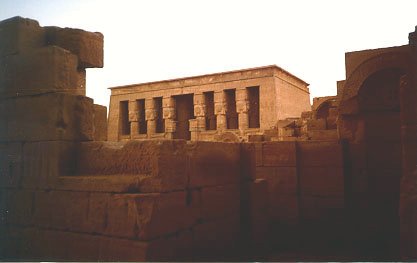 The main entrance of the
Temple of Hathor as seen from the mammisi.
It is a comparatively small propylon-style gateway rather than a large pylon as in most
other Upper Egyptian temples from the New Kingdom onwards. The temple, of Ptolemaic and
Roman date, is dedicated to a local form of Hathor who was closely identified
with Nut, as sky-goddess and daughter of Ra.
The main entrance of the
Temple of Hathor as seen from the mammisi.
It is a comparatively small propylon-style gateway rather than a large pylon as in most
other Upper Egyptian temples from the New Kingdom onwards. The temple, of Ptolemaic and
Roman date, is dedicated to a local form of Hathor who was closely identified
with Nut, as sky-goddess and daughter of Ra.
 The columns of the facade
and outer hypostyle hall of the temple
have capitals in the form of the head of Hathor surmounted by a naos-shaped sistrum, a kind of musical
rattle associated with Hathor and symbolic of joy and celebration. At Dendera, the
Egyptian New Year was celebrated. The theme of New Year's revelry and noisemaking
obviously goes back at least this far.
The columns of the facade
and outer hypostyle hall of the temple
have capitals in the form of the head of Hathor surmounted by a naos-shaped sistrum, a kind of musical
rattle associated with Hathor and symbolic of joy and celebration. At Dendera, the
Egyptian New Year was celebrated. The theme of New Year's revelry and noisemaking
obviously goes back at least this far.
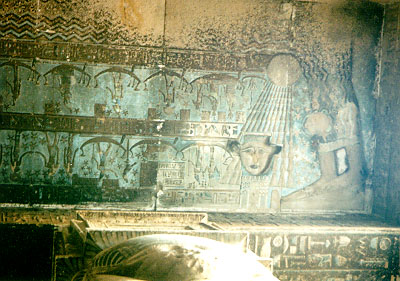 Detail of the outer
hypostyle hall's Astronomical Ceiling. The
continuing cycle of a day is represented by Nut. Her dress is the sky; between her legs is
the birth of the sun, which disappears at night as she swallows it. The sun's rays
illuminate Hathor.
Detail of the outer
hypostyle hall's Astronomical Ceiling. The
continuing cycle of a day is represented by Nut. Her dress is the sky; between her legs is
the birth of the sun, which disappears at night as she swallows it. The sun's rays
illuminate Hathor.
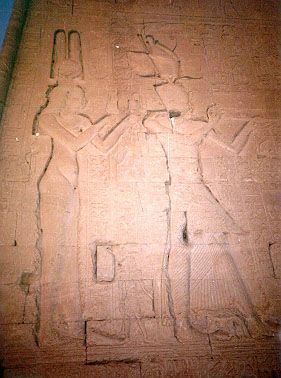 On the south exterior
wall of the temple, reliefs show offerings being made to the goddess by Cleopatra VII. This is one of the few
depictions showing the most famous of all the Cleopatras. In front of her, in
traditional Pharaonic dress, is Caesarion (Ptolemy Caesar), her son by
Julius Caesar, who Cleopatra established as her co-regent at the age of four.
On the south exterior
wall of the temple, reliefs show offerings being made to the goddess by Cleopatra VII. This is one of the few
depictions showing the most famous of all the Cleopatras. In front of her, in
traditional Pharaonic dress, is Caesarion (Ptolemy Caesar), her son by
Julius Caesar, who Cleopatra established as her co-regent at the age of four.
 A number of unfilled
cartouches reflect the uncertain political conditions of the first century BCE.
A number of unfilled
cartouches reflect the uncertain political conditions of the first century BCE.
 The Chapel of the
New Year
The Chapel of the
New Year
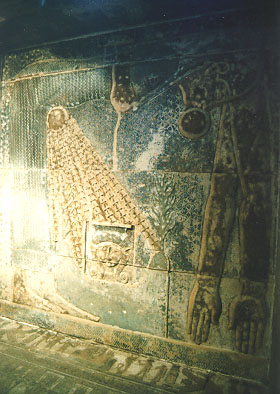 The Ceiling of the
Chapel of the New Year showing the goddess Nut swallowing the sun nightly and giving
birth to it daily. The sun's rays illuminate Hathor.
The Ceiling of the
Chapel of the New Year showing the goddess Nut swallowing the sun nightly and giving
birth to it daily. The sun's rays illuminate Hathor.
 In one corner of the roof of the
temple, a tiny, open topped shrine was used by priests once a year to allow the statue of
Hathor to feel the rays of the sun-god, Re.
In one corner of the roof of the
temple, a tiny, open topped shrine was used by priests once a year to allow the statue of
Hathor to feel the rays of the sun-god, Re.
View of the
surviving buildings as seen from the roof of the Temple of Hathor. The earliest surviving
building is a mammisi (birth-house) on the left-most side of the forecourt,
dating to the reign of Nectanebo I (380 - 362 BCE). The second mammisi,
upper-most, was built later and is referred to as the Roman mammisi. Between
the two mammisis are the remains of a basilica
of the Christian period.
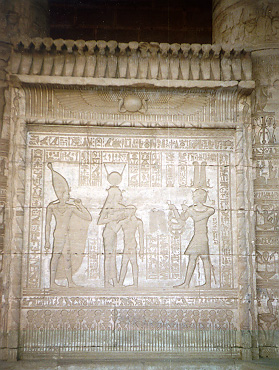 A panel from the Roman mammisi,
showing a detailed relief of the pharaoh making an offering to Hathor, who is suckling the
young Ihy. A second Ihy, wearing the White Crown of Upper Egypt, stands behind
Hathor. The Roman birth house is the latest preserved temple of its type. It
was the ritual location where Hathor gave birth to the young Ihy, who stands for the
youthful phase of the creator gods in general.
A panel from the Roman mammisi,
showing a detailed relief of the pharaoh making an offering to Hathor, who is suckling the
young Ihy. A second Ihy, wearing the White Crown of Upper Egypt, stands behind
Hathor. The Roman birth house is the latest preserved temple of its type. It
was the ritual location where Hathor gave birth to the young Ihy, who stands for the
youthful phase of the creator gods in general.
© All pictures are Copyright 1998 - 2001 Grisel Gonzalez